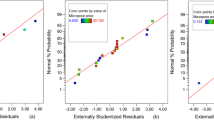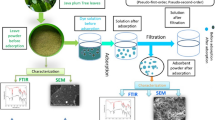Abstract
Black rice was used to produce anthocyanins, an important natural red food colorant. Integrated methods for extraction and purification of anthocyanins were investigated. Four solvents and 6 adsorbents were used for extraction and purification, respectively. Acidified 70%(v/v) ethanol resulted in the highest anthocyanin extract concentration of 461.72 mg/L. Amberlite XAD7HP had the highest adsorption capacity of 0.406±0.010 mg/g of adsorbent and desorption capacity of 0.252±0.016 mg/g of adsorbent. Acidified ethanol effectively eluted anthocyanin pigments from Amberlite XAD7HP at a concentration of 60%(v/v). Experimental adsorption data best fit to pseudosecond-order kinetic and Langmuir isotherm models. Purification parameters were optimized through dynamic adsorption/desorption experiments with Amberlite XAD7HP. The concentration of sugars (impurities) decreased from an initial 452.78 μg/mL to 169.75 μg/mL after purification.
Similar content being viewed by others
References
Lee HH, Lee JW, Rhim JW. Characteristics of anthocyanins from various fruits and vegetables. Korean J. Postharvest Sci. Technol. 7: 285–290 (2000)
Choi JH, Yeom JH, Bae DK. Utilization of natural pigment resources. Fiber Technol. Indust. 13: 113–121 (2009)
Ali S, Hussain T, Nawaz R. Optimization of alkaline extraction of natural dye from Henna leaves and its dyeing on cotton by exhaust method. J. Clean. Prod. 17: 61–66 (2009)
Food and Drug Administration. FDA/CFSAN food compliance program: Domestic food safety program. Available from: http://fda.gov. Accessed Oct. 23, 2012.
Kong S, Lee J. Antioxidants in milling fractions of black rice cultivars. Food Chem. 120: 278–281 (2010)
Castañeda-Ovando A, Pacheco-Hernández ML, Páez-Hernández ME, Rodríguez JA, Galán-Vidal CA. Chemical studies of anthocyanins: A review. Food Chem. 113: 859–871 (2009)
Francis FJ. A new group of food colorants. Trends Food Sci. Tech. 3: 27–30 (1992)
Wu X, Beecher GR, Holden JM, Haytowitz DB, Gebhardt SE, Prior RL. Concentrations of anthocyanins in common foods in the United States and estimation of normal consumption. J. Agr. Food Chem. 54: 4069–4075 (2006)
Hu C, Zawistowski J, Ling W, Kitt DD. (2003). Black rice (Oryza sativa L. indica) pigmented fraction suppresses both reaction oxygen species and nitric oxide in chemical and biological model systems. J. Agr. Food Chem. 51: 5271–5277 (2003)
Delgado-Vargas F, Jiménez AR, Paredes-López O. Natural pigments: Carotenoids, anthocyanins, and betalains. Characteristics, biosynthesis, processing, and stability. Crit. Rev. Food Sci. Nutr. 40: 173–289 (2000)
Bridgers EN, Chinn MS, Truong VD. Extraction of anthocyanins from industrial purple-fleshed sweetpotatoes and enzymatic hydrolysis of residues for fermentable sugars. Indust. Crops Prod. 32: 613–620 (2010)
Metiever RP, Francis FJ, Clydesdale FM. Solvent extraction of anthocyanins from wine pomace. J. Food Sci. 45: 1099–1100 (1980)
Srivastava J, Vankar PS. Canna indica flower: New source of anthocyanins. Plant Physiol. Biochem. 48: 1015–1019 (2010)
Hardlei TF, Morkbak AL, Nexo E. Enzymatic extraction of cobalamin from monoclonal antibody captured haptocorrin and transcobalamin. Clin. Biochem. 40: 1392–1397 (2007)
Pedersen JR, Olsson JO. Soxhlet extraction of acrylamide from potato chips. Analyst 128: 332–334 (2003)
Vinatoru M. An overview of the ultrasonically assisted extraction of bioactive principles from herbs. Ultrason. Sonochem. 8: 303–313 (2001)
Yang H, Li X, Tang Y, Zhang N, Chen J, Cai B. Supercritical fluid CO2 extraction and simultaneous determination of eight annonaceous acetogenins in Annona genus plant seeds by HPLC-DAD method. J. Pharmaceut. Biomed. Anal. 49: 140–144 (2009)
Coutinho MR, Quadri MB, Moreira RFPM, Quadri MGN. Partial purification of anthocyanins from Brassica oleracea (red cabbage). Sep. Sci. Technol. 39: 3769–3782 (2004)
Liu X, Xiao G, Chen W, Xu Y, Wu J. Quantification and purification of mulberry anthocyanins with macroporous resins. J. Biomed. Biotechnol. 5: 326–331 (2004)
Soto ML, Moure A, Domínguez H, Parajó JC. Recovery, concentration and purification of phenolic compounds by adsorption: A review. J. Food Eng. 105: 1–27 (2011)
AOAC. Official Method of Analysis of AOAC Intl. 18th ed. Method 2005.02. Association of Official Analytical Communities, Arlington, VA, USA (2005)
Crini G. Kinetic and equilibrium studies on the removal of cationic dyes from aqueous solution by adsorption onto a cyclodextrin polymer. Dyes Pigments 77: 415–426 (2008)
Ho YS, Mc Kay G. A comparison of chemisorption kinetic models applied to pollutant removal on various sorbents. Process Saf. Environ. Protect. 76: 332–340 (1998)
Langmuir I. A new adsorption isotherm. J. Am. Chem. Soc. 40: 1361–1403 (1918)
Freundlich HMF. Über die adsorption in lösungen. Z. Phys. Chem. 57: 385–471 (1906)
AOAC. Official Method of Analysis of AOAC Intl. 16th ed. Method 932.12. Association of Official Analytical Communities, Arlington, VA, USA (1995)
Hedge JE, Hofreiter BT. Estimation of carbohydrates. Vol. 17, pp. 17–22. In: Methods in Carbohydrate Chemistry. Whistler RL, BeMiller JN (eds). Academic Press, New York, NY, USA (1962)
Abdel-Aal ESM, Hucl P. Composition and stability of anthocyanins in blue-grained wheat. J. Agr. Food Chem. 51: 2174–2180 (2003)
Chen XQ, Nagao N, Itani T, Irifune K. Anti-oxidative analysis, and identification and quantification of anthocyanin pigments in different coloured rice. Food Chem. 135: 2783–2788 (2012)
Bridgers EN, Chinn MS, Truong VA. Extraction of anthocyanins from industrial purple-fleshed sweetpotatoes and enzymatic hydrolysis of residues for fermentable sugars. Ind. Crop. Prod. 32: 613–620 (2010)
Zhao Z, Dong L, Wu Y, Lin F. Preliminary separation and purification of rutin and quercetin from Euonymus alatus (Thunb.) Siebold extracts by macroporous resins. Food Bioprod. Process. 89: 266–272 (2011)
Fuleki T, Francis FJ. Quantitative methods for anthocyanins: extraction and determination of total anthocyanin in cranberries. J. Food Sci. 33: 72–83 (1968)
Mauro AD, Arena E, Fallico B, Passerini A, Maccarone E. Recovery of anthocyanins from pulp wash of pigmented oranges by concentration on resins. J. Agr. Food Chem. 50: 5968–5974 (2002)
Zhang MW, Guo BJ, Zhang RF, Chi JW, Wei ZC, Xu ZH, Zhang Y, Tang XJ. Separation, purification and identification of antioxidant compositions in black rice. J. Agr. Sci. China 5: 431–440 (2006)
Frøytlog C, Slimestad R, Andersen ØM. Combination of chromatographic techniques for the preparative isolation of anthocyanins — applied on blackcurrant (Ribes nigrum) fruits. J. Chromatogr. A 825: 89–95 (1998)
Author information
Authors and Affiliations
Corresponding author
Rights and permissions
About this article
Cite this article
Kang, Y.J., Jung, S.W. & Lee, S.J. An optimal extraction solvent and purification adsorbent to produce anthocyanins from black rice (Oryza sativa cv. Heugjinjubyeo). Food Sci Biotechnol 23, 97–106 (2014). https://doi.org/10.1007/s10068-014-0013-8
Received:
Revised:
Accepted:
Published:
Issue Date:
DOI: https://doi.org/10.1007/s10068-014-0013-8




